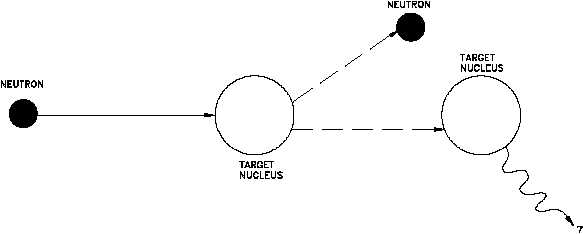Atomic and Nuclear Physics
DOE-HDBK-1019/1-93
NEUTRON INTERACTIONS
Elastic scattering of neutrons by nuclei can occur in two ways. The more unusual of the two
interactions is the absorption of the neutron, forming a compound nucleus, followed by the
re-emission of a neutron in such a way that the total kinetic energy is conserved and the nucleus
returns to its ground state. This is known as resonance elastic scattering and is very dependent
upon the initial kinetic energy possessed by the neutron. Due to formation of the compound
nucleus, it is also referred to as compound elastic scattering. The second, more usual method,
is termed potential elastic scattering and can be understood by visualizing the neutrons and
nuclei to be much like billiard balls with impenetrable surfaces. Potential scattering takes place
with incident neutrons that have an energy of up to about 1 MeV. In potential scattering, the
neutron does not actually touch the nucleus and a compound nucleus is not formed. Instead, the
neutron is acted on and scattered by the short range nuclear forces when it approaches close
enough to the nucleus.
Inelastic Scattering
In inelastic scattering, the incident neutron is absorbed by the target nucleus, forming a
compound nucleus. The compound nucleus will then emit a neutron of lower kinetic energy
which leaves the original nucleus in an excited state. The nucleus will usually, by one or more
gamma emissions, emit this excess energy to reach its ground state.
Figure 17 shows the
process of inelastic scattering.
For the nucleus that has reached its ground state, the sum of the kinetic energy of the exit
Figure 17 Inelastic Scattering
neutron, the target nucleus, and the total gamma energy emitted is equal to the initial kinetic
energy of the incident neutron.
Rev. 0
Page 45
NP-01

